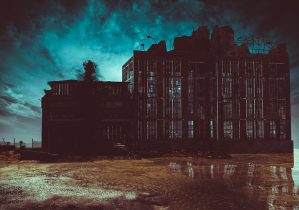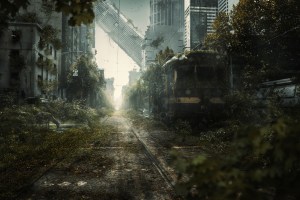Tone is important for any story, but I’d argue that it’s absolutely vital for writing horror. When your goal is to scare, the wrong tone could render those ever so important horror moments impotent. This means that, depending on the kind of story you want to write and where the terror comes from, you may want to pause and consider the tone you could use in your horror story to make it scarier, or drive home your message more effectively. After all, we are always making a statement when we feature what we fear. What are some excellent writing tones you can use when writing your horror story?
Let’s begin.
Detached
Horror doesn’t always have to be jumpscares, gore, and in-your-face brutality. Instead, sometimes subtlety is key.
When you drain all of the emotion and empathy out of a scene, replacing it with a kind of clinical detachment, the story seems colder and more hopeless. Sure, often times you can convey hopelessness and dread by writing from the perspectives of the characters and delving into every awful moment, leaving little to the imagination. But other times, sapping the emotion straight out of the tone of your writing can make events feel terrifyingly inevitable.
One way this can be done is by writing in third person omniscient point of view, meaning that the narrator knows and sees all, and the reader is always clued in to every detail about the plot as it happens. Examples of books written in third person omniscient include Lord of the Flies, The Silmarillion, and Pride and Prejudice.
You would think that horror written this way would be lacking in any suspense, but sometimes the suspense comes from knowing everything that’s going to happen as the reader, but also knowing there’s no way to stop it. I’ve found that stories written in third person omniscient have a bit of a grim edge to them, as though the narrator already knows everything is FUBAR’d and is just kind of taking a back seat to watch the chaos unfold.
Take, for example, Harlan Ellison’s “I Have No Mouth and I Must Scream,” a post apocalyptic story in which an AI with a god complex, AM, eradicates all of humanity save five unfortunate people, who he keeps alive to torture for his amusement. The story is written in third person omniscient, and there’s a level of cynical detachment that, for me, is what makes the story so impactful and terrifying aside from the concept itself.
The SCP Foundation, is another example. It’s a fictional secret organization that captures, studies, or neutralizes unusual events, creatures, people, and objects—many entries so bizarre and surreal that even the ostensibly less dangerous entries must always be treated with caution. The various entries are framed as database files, each one providing containment procedures, a description, and any additional notes or audio/transcript files. Other fans of the SCP Foundation might disagree, but I for one have always found the files more interesting and creepy than the short stories you can also find on the site, with a few exceptions. It’s proof that playing around with framing devices and perspectives is one way to find the right tone for your horror story, and in this case, learning about unusual creatures, objects, and events through straightforward, impersonal research files adds some cynicism to every entry that I found increases the appeal.
Cheerful/Whimsical
There’s something about juxtaposing a truly horrific situation with a carefree, fairy tale-esque tone that makes the horror more, well, horrifying. If you’re writing a film, that tone could come across visually and auditorily: bright lighting, flowers, butterflies, birds chirping, children laughing, cheerful music; anything you can think of that would give the watcher the impression that, hey, perhaps they aren’t watching a horror movie at all! It only makes the inevitability of things going downhill all the more dreadful to anticipate.
When I think of writing a horror story with a cheerful, whimsical tone, I often think of the film Midsommar, filmed in bright lighting and featuring bright clothing, smiling extras, and gorgeous scenery. (Spoiler alert) This makes the characters’ witnessing of the ättestupa, the ritual sacrifice of the elderly who could no longer care for themselves via throwing themselves off a cliff—more gruesome and impactful.
If you’re writing your story, however, this tone could come across in much the same way, but through your characters’ perception of it. Shirley Jackson’s “The Lottery,” for example, is written in a tone that’s casual and almost cheerful and celebratory, filled with anticipation as we read about young children seeking out smooth rocks to stuff in their pockets and the other townsfolk treating the annual lottery the same as any other community event (literally: it’s mentioned in the same context as “square dances, the teen-age club, [and] the Halloween program”). So it’s quite jarring when the reader learns what the lottery really is: a random member of the community being selected for a stoning.
This is the kind of tone that works best if you want to create a contrast, or perhaps leave your reader/viewer with a feeling of anticipation or dread. When we’re watching a horror movie, we know we’re not in for a good, cheerful time. Something is wrong, but what? And when will the other shoe finally drop? If that’s the kind of horror story you want to write, then giving your reader/viewer very little information initially and no signs pointing tonally to anything wrong is one way you can deliver the horror effectively.
Bleak
A classic.
When we think horror, we often think “bleak, hopeless, creepy.” This is the kind of tone you use for your tried and true “spooky horror story” situation: the haunted asylum, the zombie apocalypse, the Saw-esque torture porn. They’re the stories where the horror is relentless; you do not want to give the reader/viewer a break, and there are few, if any, moments of respite. It’s your humorless, hopeless, “I think I would rather die than be caught in this situation” kind of horror.
Some examples that pop into my mind include The Walking Dead, The Thing, Martyrs, and The Mist. Notice that most of these examples also have a sense of loneliness or isolation, which is another important tone you can utilize in horror that we’ll talk about later.
If you’re creating visual horror media like a short film or a webseries, you can easily give your film a bleak tone through dim, blue-ish lighting (see above), quiet or absolutely no music, creaking floorboards, whispers, whistling wind, zombies groaning, or any sights or sounds that make the setting depressing and eerie. Zombie movies are great with this. There are few things more grim than seeing your friends and loved ones die and return as a mindless, rotting corpse. Take a whole zombie apocalypse that ends society as we know it, leaving only scattered colonies of survivors behind, and you have the perfect setting to get real bleak.
If you’re writing a horror short story or novel, ask yourself how the setting might affect how the characters feel. Do they feel a chill run up their spine, or like something is watching them every waking moment? Are they in a scenario where taking even a single wrong turn could result in disaster? What are the stakes, and how can you use the things we humans fear to show the reader how high those stakes are and how grim the situation looks? What hope do the characters have, and how can you take that away from them? The key for horror stories with a bleak tone is that there is often very little humor or joy. And while it’s not a rule, it’s also fairly common for the bleaker horror stories to have a bleak ending as well. There’s no respite from the misery, friendos, not even at the end.
Surreal
I think of horror stories with a surreal tone as a bit similar to those with a whimsical or uplifting tone: something is wrong, but it’s not clear what.
If you’ve ever heard of the uncanny valley or liminal spaces, that is what I mean by surreal. If you haven’t heard of it, the uncanny valley is the uneasy feeling humans get when perceiving something eerily similar to human, but…not quite. Think mannequins, badly CGI’d characters, or the feeling you get when looking at an algorithm that generates random faces of people who are not real.
Liminal spaces are things that evoke a deep sense of nostalgia; locations from the past, often deserted now. Think abandoned water parks, that one neighborhood you could swear you’ve seen in a dream before, or an old restaurant transported straight out of the 90s (neon lights, that funky colorful floor pattern, those blue and white “jazz” soda cups).
There’s something surreal and, yes, a little creepy about seeing something that was vibrant in your youth enter an abandoned and decrepit state, creating a sense of both familiarity and discomfort. There’s also something surreal and creepy about looking at someone (or something) that looks human, yet can trigger a primal instinct within you that screams danger.
Personally, I always love horror that scares me without my entirely understanding why. Using a surreal tone in your horror story is great for creating a creeping sense of fear, unease, and confusion. It might be why I’m quite fixated on urban legends and horror lore like the SCP Foundation or The Backrooms.
The Backrooms in particular uses this surreal, eerie tone quite effectively by transforming these places that give you a feeling of unease into locations outside of our dimension, where you can “glitch” out of reality at any time and wind up trapped for eternity or chased by mysterious entities. Take a moment to look up images like “liminal space,” “uncanny valley,” “surreal landscape,” or “surreal art” to get a good idea of the tone you want to set and see if your story might work well as an abstract, eerie, nostalgic piece.
Lonely/Isolated
As a hardcore introvert, I can go a long time without speaking a word to anyone. Like, days.
But humans are social creatures. Even those of us who don’t get lonely easily will still get lonely eventually. And that’s what makes stories with a lonely tone so grim.
In addition to the feeling of loneliness, horror with a more isolated/lonely tone tends to also be either very claustrophobic (The Descent, The Thing, Saw) or so spacious that it makes the protagonist(s) and the viewer feel small and insignificant (I Am Legend, World War Z, The Road). Post-apocalyptic stories work particularly well with this tone, as the fear comes from the death of humanity and the feeling of isolation being alone on a whole planet of fallen civilizations.
To write a horror story that feels very isolated, first ask yourself this: what are some places you would hate, hate to be caught alone in? A graveyard? An abandoned hospital? A spooky forest?
Once you’ve determined where you want your story to be set, have your protagonist tackle their problems in this lonely setting—you guessed it—alone. Their phone doesn’t work. They didn’t tell anyone where they were going before they left, so no one knows where they are. They’re just a naturally lonely person who doesn’t have anyone to turn to for help. Whatever the reason, they are alone, and no one is coming to find them.
Finally, ask yourself what situations would be the worst to be alone in. Perhaps they were in a plane crash and are the lone survivor in the middle of snowstorm in the wilderness. Or they went on a solo hike and are being stalked by something. Or they’ve been kidnapped and their only companion is darkness and their cruel tormentor. Or they live alone on a quiet farm in the countryside and one day encounter a home invader with the nearest neighbor who could help them miles and miles away.
Hell, your story could have a lonely tone without the protagonist even being alone. Take, for example, a story about a young woman enduring some horrific, eldritch event. She’s scared and confused, so she goes to her partner for help. Her partner doesn’t believe her. Worse, her partner gaslights her, calls her crazy. The horror is technically in the horrific supernatural happening that this woman is experiencing, but it’s also in the feeling of loneliness, having someone right beside you who is supposed to love and support you unconditionally, but treats the whole situation as nothing more than a nuisance. There’s something truly lonely about having someone right next to you but still feeling completely alone.







The horror focus lately has been great. Really useful, this one in perticular!